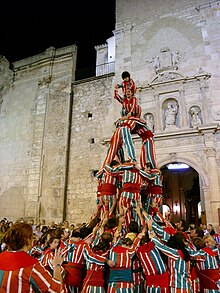Muixeranga
Muixeranga [ muˑiˑʃeˈranga ] is the collective name for traditional street dances and castells (human pyramids ) that originate in the area around Valencia and are still performed in the town of Algemesí (approx. 30 km southwest of Valencia).
The Muixeranga is much more than an acrobatic dance, it is a collection of historical choreographies of outstanding plasticity, which are performed at the town festival of Algemesí in honor of the so-called Virgin of Health ( Mare de Déu de la Salut ) on September 8th each year.
The Muixeranga is in many ways similar to the human pyramids ( castells ) that are built in Catalonia on many festive occasions. Both traditions share a common origin, the Moixiganga , which used to be found all over the Iberian Peninsula .
In contrast to the castells, the Muixeranga has a more religious background, is accompanied by a dance and does not serve the ambition to form the highest possible human pyramid, but rather tries to create a plastic, figurative scene.
Characteristic
The pyramids are usually formed by a group of men who can be of any occupation but should be strong and skilled. Nowadays these groups number about 200 men in total, in the past it was certainly not much more than 30. There is a master of ceremonies who coordinates the dances and human figures, and he is also responsible for the admission and training of new members.
The clothing is idiosyncratic in many ways. It consists of a shirt, pants, work shoes and sometimes a special hat. The fabric is patterned with vertical red and blue stripes on a white background, almost like a harlequin costume . It seems as if this strange appearance came about by chance, older people remember that the costumes used to be made from the upholstery fabric for mattresses.
Origin and development
There are various theories as to the origin of the Muixeranga, especially as to the name. One theory suggests that the term comes from the Arabic word mochain (mask).
Although this tradition on the Iberian Peninsula probably goes back to the 13th century , the first written mention of the Muixeranga in Algemesí takes place in the first third of the 18th century . The strongly developed tradition suggests a much older origin. If one relies on references, then the first celebrations in honor of the Virgin of Health took place in 1724 , the first specific date can be set to 1733 . This year, the city chronicle mentions an amount that was granted to the Dolçaina players for their participation in the festival.
Music and symbols
The dance is accompanied by music on tabalet (a drum ) and dolçaina (a very loud flute ). A characteristic melody is played, the author of which is unknown. The music of the Muixeranga was proposed as a kind of anthem for the Valencian region or the entire Països Catalans by people fighting to revive the Valencian culture and language .
Hear the Muixeranga music ![]() played by Xavier Richart.
played by Xavier Richart.
Web links
- Unofficial website of the Muixeranga (parts of the original article were taken from this website with permission)
- Website unofficial of the "Moixiganga de Vilanova i la Geltrú"
- Facebook unofficial of the "Moixiganga de Vilanova i la Geltrú"
